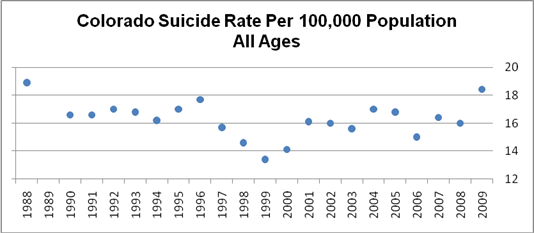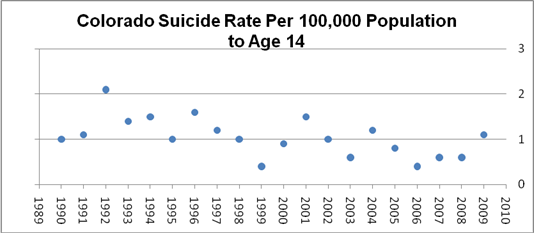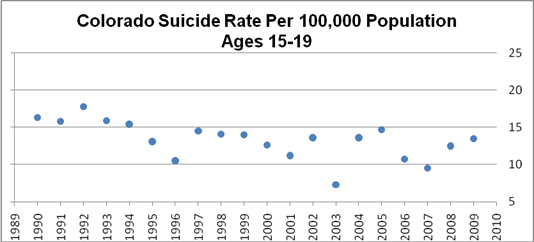Data being misused to alarm the public is consistent with marketing programs of the psychiatric-pharmaceutical industry
Data recently released by the Colorado Department of Public Health and Environment show that the trend in suicides in the state in effect has been statistically flat for at least 22 years. There are wide fluctuations from year to year in the rate of suicides per 100,000 population, but all within a long-term, essentially unchanged trend, as the chart below of the data illustrates. There isno suicide epidemic in Colorado.

Particularly false is the claim of a supposed epidemic of suicides among young people. The fact is that suicide is very rare among children. While the death of any child is tragic, statewide there were just 11 suicides last year in an estimated population of 1,040,402 children through age 14, for a rate of 1.1 suicide per 100,000 in 2009 – almost exactly the same rate as the 20-year average rate for this age group of 1.0. The facts show there is no suicide epidemic among younger children.

Concerning teenage suicides, the statistic currently making headlines is that suicide is the second-leading cause of death among teenagers in Colorado. But this is only because there are very few teenage deaths for any reason. While the death of any child is tragic, the fact is that there were 49 suicides last year in an estimated population of 362,423 teens ages 15 through 19 statewide, for a rate of 13.5 suicides per 100,000 population in 2009 – almost exactly the same rate as the 20-year average rate for this age group of 13.1. The facts show that suicides are not spreading more rapidly or extensively among teenagers. There is no suicide epidemic.

At a minimum, these statistics stand as testament to the monumental failure of psychiatry to lower the suicide rate after decades of prescribing antidepressants in Colorado – to the point that antidepressant residues are measurable in our waterways.
More alarming is the fact that psychiatric drugging is leading to suicides. An estimated 50% of all Americans who commit suicide are on psychiatric drugs.
Antidepressants are known to cause worsening depression, birth defects, sexual dysfunction, anxiety, panic attacks, hostility, aggression, psychosis, violence, suicide and many, many other adverse events. Long-term antidepressant users frequently report that their emotions have been deadened so much that they feel like zombies.
The dangers of antidepressants have led the FDA and regulatory authorities around the word to issue warnings concerning their use, including the FDA’s most severe, “black box” warning.
International warnings & studies on psychiatric drugs can be found through the Citizens Commission on Human Rights International’s psychiatric drug search engine.
Adverse psychiatric drug reactions reported to the U.S. Food and Drug Administration’s Medwatch can be searched here.
Despite the fact that the suicide rate for teenagers in Colorado has been essentially unchanged for at least 20 years, “suicide as the second-leading cause of death among teenagers” is being used to gain sympathy and support from the public, school administrators, physicians, public officials, and state legislators for requiring children to be screened for depression in the name of suicide prevention.
The screening surveys used, however, consider the normal variations in human behavior as symptoms of mental illness. In particular, teenagers, with their wide range of behavior, are found to have “mental disorders” in high numbers. This is because screening that targets teenagers, such as TeenScreen, asks questions that could be answered “Yes” by almost any normal teenager, such as:
- Has there been a time when nothing was fun for you and you just weren’t interested in anything?
- Has there been a time when you felt you couldn’t do anything well or that you weren’t as good-looking or as smart as other people?
- How often did your parents get annoyed or upset with you because of the way you were feeling or acting?
- Have you often felt very nervous when you’ve had to do things in front of people?
- Have you often worried a lot before you were going to play a sport or game or do some other activity?
A pilot program using TeenScreen should serve as a chilling warning to Coloradoans about what it means when teenagers are screened for depression. During 2001-03, TeenScreen was used on teenagers at a Denver public high school and a Denver homeless shelter. The results, unabashedly published at the time on the website of the Mental Health Association of Colorado (now Mental Health America of Colorado), are shocking to anyone – except apparently those with ties in with the psychiatric industry:
- Half (50%) of the screened high school students were found to be at risk of suicide!
- Nearly three out of four youths (71%) screened at the homeless shelter were found to have psychiatric disorders!
Clearly these screening surveys are identifying all sorts of young people as “mentally ill” when they are not. Even the developer of the TeenScreen survey, psychiatrist David Shaffer, who has been the recipient of huge dollars from pharmaceutical companies (see “TeenScreen, A Front Group for the Psycho-Pharmaceutical Industrial Complex”), himself admits that TeenScreen “does identify a whole bunch of kids who aren’t really suicidal, so you get a lot of false-positives. And that means if you’re running a large program at a school, you’re going to cripple the program because you’re going to have too many kids you have to do something about.”
And what happens when the screening identifies so many children “you have to do something about?” It means a bonanza for the pharmaceutical companies and the psychiatrists who make a living from psychiatric drugging. Young people with their wide range of childhood behavior, or with behavioral symptoms caused by any number of underlying, often undiagnosed physicalillnesses or abnormalities, will be labeled with “mental disorders” that follow them through life.
They will likely get referred to a psychiatrist, who will in all probability prescribe powerful, mind-altering psychiatric drugs, with their long lists of harmful and even life-threatening side effects. The results of a survey published several years ago in the Journal of the American Academy of Child and Adolescent Psychiatry revealed that 9 out of 10 children who see a psychiatrist will be prescribed psychiatric drugs.
The facts show that there is no epidemic of suicides in Colorado. So who is behind the hysteria being whipped up in the state over suicides? Pharmaceutical companies have three steps in their marketing programs, the first of which is to elevate the importance of a condition, making it appear far more serious & widespread than previously thought. This first step is well underway in Colorado, forwarded by psychiatrists and psychiatric-industry front groups like the National Alliance on Mental Illness (NAMI), using disinformation about a nonexistent “epidemic of suicides” supposedly sweeping the state.
The story of the unholy alliance between psychiatry and the drug companies, with the slick marketing schemes and scientific deceit that have created an $80 billion profit center, has been documented in “The Marketing of Madness: Are We All Insane?”, a multi-award-winning documentary film produced by CCHR International. To order your free copy of the DVD, click here.
If you, a loved one, or someone you know has been harmed by a psychiatrist or other mental-health worker and you want to talk about it, we want to talk to you. Email us or call 303-789-5225. All inquiries and communication will be handled in strictest confidence. We will take action.




